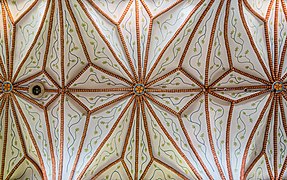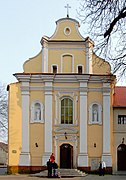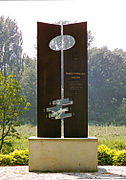Szamotuły


 Poland
Poland Greater Poland
Greater PolandSzamotuły [ʂamɔˈtuwɨ] (German: Samter, Yiddish: Zamter[1]) is a town in western Poland, in Greater Poland Voivodeship, about 35 kilometres (22 miles) northwest of the centre of Poznań. It is the seat of Szamotuły County and of the smaller administrative district Gmina Szamotuły. The population was 19,090 in 2011.
History

Szamotuły was probably founded in the 11th century, and was first mentioned in documents in 1231. Duke Przemysł I of Greater Poland established local fairs before 1257. Szamotuły was granted town rights in 1383 or earlier. It was a private town of Polish nobility, administratively located in the Poznań County in the Poznań Voivodeship in the Greater Poland Province of the Polish Crown.[2]
During the joint German-Soviet invasion of Poland, which started World War II in September 1939, the town was invaded and then occupied by Germany. On September 12, 1939, the German Einsatzgruppe VI entered the town to commit various atrocities against Poles as part of the Intelligenzaktion.[3] The Germans carried out mass arrests of local Poles under the pretext of "gathering, plotting, mistreating the Volksdeutsche and anti-German activity".[4] Arrested Poles from the town and county were imprisoned in a newly established Nazi prison, and then hundreds were massacred in the nearby Bytyń, Kobylniki and Mędzisko forests between October 1939 and January 1940.[5] On October 12–13 and December 13, 1939, the Germans also carried out public executions of Poles in the town.[6] In December 1939, the Germans carried out first expulsions of Polish intelligentsia and owners of shops and workshops, which were then handed over to German colonists as part of the Lebensraum policy.[7] Further expulsions of Poles were carried out in 1940–1941 and 1944.[8] Despite such circumstances, the Polish resistance movement was active in the town, and structures of the Polish Underground State were organized.[9] The Germans also destroyed the pre-war monument of Polish insurgents of the Greater Poland Uprising.[10] In 1945 the German occupation ended and the town was restored to Poland, although with a Soviet-installed communist regime, which remained in power until the Fall of Communism in the 1980s. In June 1945, the Home Army carried out a successful attack on a communist prison and liberated captured resistance members.[11]
Sports
The local football club is Sparta Szamotuły. It competes in the lower leagues.
Notable people
- Wacław z Szamotuł (1520s-1560s), composer and writer
- John Jonston (1603-1675), natural scientist and historian
- Siegmund Lubszynski (Lubin) (1841-1923), American film pioneer, the first Jewish "Movie Mogul"
- Philipp Scharwenka (1847-1917), composer and music educator
- Xaver Scharwenka (1850-1924), composer and pianist
- Hans Georg Friedrich Groß (1860-1924), German balloonist and airship constructor
- Alexander Hollaender (1898–1986), scientist
- Maksymilian Ciężki (1899-1951), cryptographer
- Ernst Wellmann (1904–1970), Wehrmacht officer
- Małgorzata Braunek (1947-2014), actress
International relations
Twin towns – Sister cities
Szamotuły is twinned with:
|
Gallery
-
 Górka Castle seen from the park
Górka Castle seen from the park - Gothic Minor Basilica Church (formerly Collegiate Church)
-
 Vault of the Gothic Collegiate Church
Vault of the Gothic Collegiate Church -
 Baroque Holy Cross Church
Baroque Holy Cross Church -
 Fountain in the old park
Fountain in the old park -
 Monument to officer and cryptographer Maksymilian Ciężki
Monument to officer and cryptographer Maksymilian Ciężki
References
- ^ Beider, Alexander (2012). "Eastern Yiddish Toponyms of German Origin" (PDF). Yiddish Studies Today. ISBN 978-3-943460-09-4, ISSN 2194-8879 (düsseldorf university press, Düsseldorf 2012). Retrieved 26 December 2023.
- ^ Atlas historyczny Polski. Wielkopolska w drugiej połowie XVI wieku. Część I. Mapy, plany (in Polish). Warszawa: Instytut Historii Polskiej Akademii Nauk. 2017. p. 1a.
- ^ Wardzyńska, Maria (2009). Był rok 1939. Operacja niemieckiej policji bezpieczeństwa w Polsce. Intelligenzaktion (in Polish). Warszawa: IPN. p. 60.
- ^ Wardzyńska (2009), p. 116
- ^ Wardzyńska (2009), p. 117, 199-200
- ^ Wardzyńska (2009), p. 193
- ^ Wardzyńska, Maria (2017). Wysiedlenia ludności polskiej z okupowanych ziem polskich włączonych do III Rzeszy w latach 1939-1945 (in Polish). Warszawa: IPN. p. 160. ISBN 978-83-8098-174-4.
- ^ Wardzyńska (2017), p. 204, 280, 375
- ^ Pietrowicz, Aleksandra (2011). "Konspiracja wielkopolska 1939–1945". Biuletyn Instytutu Pamięci Narodowej (in Polish). No. 5–6 (126–127). IPN. p. 36. ISSN 1641-9561.
- ^ Wardzyńska (2017), p. 143
- ^ Łuczak, Agnieszka (2011). "Podziemie niepodległościowe w Wielkopolsce w latach 1945–1956". Biuletyn Instytutu Pamięci Narodowej (in Polish). No. 5–6 (126–127). IPN. p. 77. ISSN 1641-9561.
External links
- Official city webpage
- v
- t
- e





















